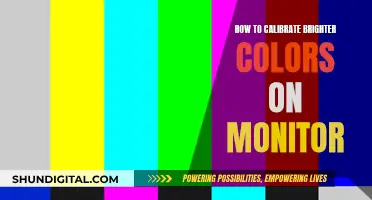
Calibrating your monitor is essential for ensuring colour accuracy and consistency in your images. The process can seem intimidating, but it is relatively simple and only takes a few minutes. The Datacolor SpyderX Pro, for example, can calibrate your monitor in under two minutes, while more comprehensive calibrations can take up to 20 minutes. Regular calibration, ideally once a month or every two to six weeks, is necessary to maintain accuracy as screen brightness, contrast, colour accuracy and temperature gradually change over time.
| Characteristics | Values |
|---|---|
| First-time calibration time | 20 minutes |
| Recalibration time | 2 minutes |
| Calibration frequency | Every 2-6 weeks |
What You'll Learn

First-time calibration takes around 20 minutes
Calibration is an essential step in ensuring that your monitor displays colours accurately and consistently. It is particularly important for photographers, videographers, graphic designers, and other professionals who rely on accurate colour representation in their work. While the process may seem intimidating at first, calibrating your monitor for the first time is a straightforward task that will only take around 20 minutes.
To calibrate your monitor, you will need a calibration tool or device, commonly known as a colourimeter. These devices are relatively affordable and can be easily purchased online or from electronics stores. Once you have acquired a colourimeter, such as the highly recommended SpyderX from Datacolor, you can begin the calibration process.
The first time you calibrate your monitor, it will take a bit longer as you will need to read the instructions and download the necessary software. Give yourself about 10 minutes for this step. The software will guide you through the process, including when to plug in your calibration device. It will also provide you with a checklist to ensure your monitor is properly set up for calibration.
After the initial setup, the calibration process itself is quite fast. The device will be placed over your screen, and the software will display various colours and tones in sequence. The colourimeter will measure the colours and tones displayed, including their RGB makeup and overall brightness. This automated process will take just a few minutes, and you will then be prompted to name and save the resulting profile.
Once calibration is complete, you can compare your previous uncalibrated view with your new, accurate colour profile. You will likely notice a significant improvement in colour accuracy and consistency. By calibrating your monitor, you can be confident that the colours and brightness on your screen accurately represent the images you capture and edit.
Cleaning Monitors: Removing Streaks and Fingerprints
You may want to see also

Recalibration takes less than 10 minutes
Calibration is an essential step in ensuring that your monitor displays accurate and consistent colours. While the initial calibration process may take up to 20 minutes, subsequent recalibrations are much faster and can be completed in less than 10 minutes. This makes it easy to maintain accurate colours and brightness on your monitor.
The time required for recalibration depends on the tool you are using. For example, the Datacolor SpyderX Pro offers a quick and easy solution, taking less than two minutes to recalibrate your screen. With its intuitive software, you can be confident that your monitor will display colours accurately, just the way you intended.
Recalibration is a simple task that can be done regularly to maintain the optimal performance of your monitor. It is recommended to calibrate your monitor every two to six weeks, or at least once a month. This ensures that your monitor remains accurate as colour temperature and screen brightness gradually change over time.
By investing a small amount of time in recalibration, you can ensure that your monitor provides you with consistent and reliable results. This is especially important for photographers, videographers, and designers who depend on accurate colour representation in their work. With a properly calibrated monitor, you can be confident that your printed output will match what you see on the screen.
Troubleshooting an ASUS Monitor That Won't Stay Asleep
You may want to see also

Calibration is required every 2-6 weeks
Calibration is an essential part of your editing workflow. It ensures that your monitor displays colours accurately and consistently. Most calibration software suggests that you calibrate your monitor(s) every 2-6 weeks. This frequency of calibration ensures that everything is accurate, from colour temperature to screen brightness.
Over time, your monitor's screen brightness, contrast, colour accuracy, and colour temperature will gradually change. Calibration is necessary to compensate for these changes and maintain the accuracy of your display. While high-end brands may calibrate their monitors in the factory, this does not guarantee that they will stay calibrated or that they are calibrated correctly for your specific needs.
The time it takes to calibrate your monitor depends on the device and software you are using. Calibrating your monitor for the first time will likely take longer than subsequent calibrations. With the Datacolor SpyderX Pro, the first calibration will take around 20 minutes, while subsequent calibrations will take less than two minutes. Other calibration tools, like the Spyder X/X2, can calibrate your monitor in under two minutes, even for the initial calibration.
It's important to note that different monitors may have different calibration settings, and the calibration process may vary slightly between devices. Additionally, the type of monitor you have (LCD, LED, HDR LCD, etc.) can also impact the calibration process.
By calibrating your monitor every 2-6 weeks, you can be confident that your monitor displays accurate and consistent colours. This is especially important for photographers, videographers, graphic designers, and other professionals who rely on accurate colour representation in their work.
Adjusting Screen Brightness: Windows Settings or Calibration?
You may want to see also

Calibration improves colour accuracy
Calibration is the process of fine-tuning your monitor's settings to ensure precise colour representation. It is essential for producing a neutral white with no colour shift and ensuring that other colours are as accurate as possible under the ambient light conditions you are working under. This is particularly important for professionals in visual content creation, such as photographers, videographers, graphic designers, and digital artists, as it can improve work efficiency and management, save costs, and increase client satisfaction.
The colour accuracy of a monitor gradually changes over time, and ambient lighting can also affect how colours are perceived. Therefore, it is recommended to calibrate your monitor regularly, with most calibration software suggesting that monitors be calibrated every two to six weeks. Additionally, it is important to note that not all monitors are calibrated to the same standards by different manufacturers, and monitors will shift in colour, contrast, and brightness as they age.
There are various tools available for monitor calibration, including software-only solutions and more advanced external hardware devices known as colourimeters. Computer manufacturers like Microsoft and Mac provide built-in software for monitor calibration, and there are also third-party solutions available for download. These software systems are designed to optimise graphics card settings and typically come with instructions and references that teach users how to adjust brightness, colour contrast, and other settings.
For more precise colour correction, external hardware devices such as colourimeters can be used. These devices connect to the monitor via a USB port and come with software that can be downloaded from the manufacturer's website. The hardware's built-in sensors interact with the software to generate a calibration profile, and they can also measure ambient light in the room and make adjustments accordingly.
In summary, calibration improves colour accuracy by allowing users to fine-tune their monitor's settings and maximise the colour performance and accuracy of their display. This ensures that the colours on the screen accurately represent the colours in the original image or scene, which is crucial for professionals in visual content creation. Regular calibration and the use of appropriate tools can help maintain colour accuracy over time and across different working environments.
Swimming with an Ankle Monitor: What You Should Know
You may want to see also

Calibration is simple and doesn't require a technical background
Calibration is a simple process that doesn't require a technical background. While the idea of calibrating your monitor can seem intimidating at first, it is actually very straightforward. You will probably need a calibration tool, but these are relatively affordable and can be a great investment.
The calibration process involves using a small "hockey puck"-sized device that you hang over your computer screen. You then run a program that comes with the device, which displays various colours and tones in sequence. The device measures the colours being displayed, including their exact RGB makeup and their overall brightness. This process is called colourimetry.
One of the best calibration tools on the market is the SpyderX from Datacolor. The SpyderX software offers one-click calibration options with industry-set standards for new users, as well as fully customisable settings for experienced users. The creation of the calibration profile is done automatically by the Spyder software and saved in the correct place on the operating system. With the SpyderX, calibration can be done in under 2 minutes!
Using a monitor calibration device such as the Datacolor SpyderX Elite or SpyderX Pro is easy, as the software that comes with them will walk you through the entire process. Once you download, install, and open the calibration software, it will tell you when to plug in the calibration device. Then, you select "Calibrate My Display" and click next. The app will provide you with a checklist of things to be sure of before moving forward, such as the physical contrast buttons/settings on your display.
After that, you select your monitor type: LCD, LED, HDR LCD, etc. Lastly, you click next to move into the workflow selection, where you can choose a step-by-step assistant or simply choose a profile to match from another monitor. The next step is to select the calibration depth for your screen. Given that the process is so fast, a full calibration can be done once a month to ensure that your monitor is getting the best colour presentation possible.
So, if you're looking to calibrate your monitor, don't be intimidated! The process is simple and doesn't require any technical expertise. With the right tools and software, you can have your monitor calibrated in no time.
Acer Predator Monitors: Worth the Investment?
You may want to see also
Frequently asked questions
The first calibration will take about 20 minutes, 10 of which will be spent reading instructions and downloading the software. Subsequent calibrations will take less than 2 minutes each with the Datacolor SpyderX Pro.
Most calibration software suggests that you calibrate your monitor(s) every 2-6 weeks to ensure accuracy. However, if you are a photographer, you may want to calibrate your monitor at least once every six months or once a month.
Health monitors can take up to 48 hours to calibrate.







